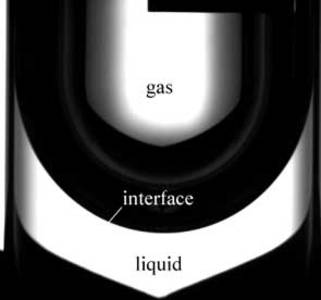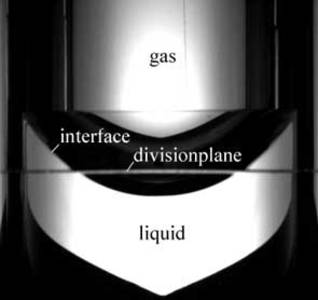drop tower experiment
In this study the reorientation behavior of a free liquid interface in a partly filled right circular cylinder upon step reduction in gravity is investigated experimentally. The experiments focus on the investigation of non-isothermal effects on the liquid reorientation. The situation is similar to a spacecraft which enters a ballistic flight after the end of thrust. Heat flux between the liquid propellant and the tank wall takes place and influences the reorientation behavior.
Microgravity conditions were obtained after the release of a drop capsule in the drop tower facility Bremen. For the initial condition the system is dominated by hydrostatic forces. In this case the equilibrium of the free liquid surface is generally characterized by a flat shape with a curvature at the cylinder wall given by the static contact angle. After transition to reduced gravity, capillary forces govern the flow and a capillary driven reorientation of the liquid to the new equilibrium position (Fig. 1) is established in a damped oscillation. If temperature differences between liquid and wall are present the reorientation is superposed by a flow due to thermal effects in the vicinity of the contact line. Marangoni effects influence the contact line behavior and the apparent dynamic contact angle (Fig. 2). Since the characteristics of the reorientation such as frequency and the damping are governed by the behavior of the contact line the thermal effects have a significant influence.


The test setup is designed to enable a cold liquid to spread along a hot vessel wall. The test vessel consists of two compartments. The upper part is heated inside a furnace before the drop test. The lower part stores the test liquid at ambient temperature. Just prior to the experiment start the vessel is closed and thus the hot and cold compartments are connected.
publications
Gerstmann, J., Dreyer, M. E.: The dynamic contact angle in the presence of a non-isothermal boundary condition, Microgravity sci. tec. XIX/3-4 (2007).


 "
"